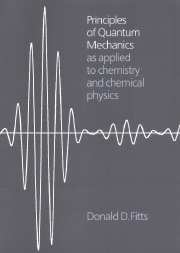Book contents
- Frontmatter
- Contents
- Preface
- Chapter 1 The wave function
- Chapter 2 Schrödinger wave mechanics
- Chapter 3 General principles of quantum theory
- Chapter 4 Harmonic oscillator
- Chapter 5 Angular momentum
- Chapter 6 The hydrogen atom
- Chapter 7 Spin
- Chapter 8 Systems of identical particles
- Chapter 9 Approximation methods
- Chapter 10 Molecular structure
- Appendix A Mathematical formulas
- Appendix B Fourier series and Fourier integral
- Appendix C Dirac delta function
- Appendix D Hermite polynomials
- Appendix E Legendre and associated Legendre polynomials
- Appendix F Laguerre and associated Laguerre polynomials
- Appendix G Series solutions of differential equations
- Appendix H Recurrence relation for hydrogen-atom expectation values
- Appendix I Matrices
- Appendix J Evaluation of the two-electron interaction integral
- Selected bibliography
- Index
- Physical constants
Preface
Published online by Cambridge University Press: 05 June 2012
- Frontmatter
- Contents
- Preface
- Chapter 1 The wave function
- Chapter 2 Schrödinger wave mechanics
- Chapter 3 General principles of quantum theory
- Chapter 4 Harmonic oscillator
- Chapter 5 Angular momentum
- Chapter 6 The hydrogen atom
- Chapter 7 Spin
- Chapter 8 Systems of identical particles
- Chapter 9 Approximation methods
- Chapter 10 Molecular structure
- Appendix A Mathematical formulas
- Appendix B Fourier series and Fourier integral
- Appendix C Dirac delta function
- Appendix D Hermite polynomials
- Appendix E Legendre and associated Legendre polynomials
- Appendix F Laguerre and associated Laguerre polynomials
- Appendix G Series solutions of differential equations
- Appendix H Recurrence relation for hydrogen-atom expectation values
- Appendix I Matrices
- Appendix J Evaluation of the two-electron interaction integral
- Selected bibliography
- Index
- Physical constants
Summary
This book is intended as a text for a first-year physical-chemistry or chemical-physics graduate course in quantum mechanics. Emphasis is placed on a rigorous mathematical presentation of the principles of quantum mechanics with applications serving as illustrations of the basic theory. The material is normally covered in the first semester of a two-term sequence and is based on the graduate course that I have taught from time to time at the University of Pennsylvania. The book may also be used for independent study and as a reference throughout and beyond the student's academic program.
The first two chapters serve as an introduction to quantum theory. It is assumed that the student has already been exposed to elementary quantum mechanics and to the historical events that led to its development in an undergraduate physical chemistry course or in a course on atomic physics. Accordingly, the historical development of quantum theory is not covered. To serve as a rationale for the postulates of quantum theory, Chapter 1 discusses wave motion and wave packets and then relates particle motion to wave motion. In Chapter 2 the time-dependent and time-independent Schrödinger equations are introduced along with a discussion of wave functions for particles in a potential field. Some instructors may wish to omit the first or both of these chapters or to present abbreviated versions.
Chapter 3 is the heart of the book. It presents the postulates of quantum mechanics and the mathematics required for understanding and applying the postulates.
- Type
- Chapter
- Information
- Principles of Quantum MechanicsAs Applied to Chemistry and Chemical Physics, pp. viii - xPublisher: Cambridge University PressPrint publication year: 1999

